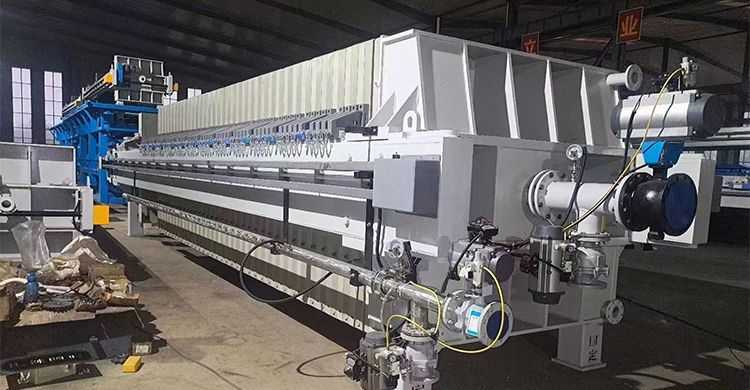+86-18931636908
- Home
-
-
-
+
-
-
-
+
-
-
-
+
- Applications
- Contact
-
-
-
+
 Language
Language
The currently used plate and frame filter presses, belt filter presses, centrifugal dewatering machines, etc. generally can only ensure a mud moisture content of about 78%. The diaphragm type plate and frame filter press has the advantages of high solid content and strong reliability in sludge discharge. Combined with chemical conditioning, it can maintain the moisture content of dehydrated sludge below 60%. After entering the sludge, the diaphragm frame filter press uses a diaphragm press pump to inject high-pressure water into the diaphragm plate of the filter press, and uses the tension of the diaphragm to squeeze and dehydrate the sludge. The filtrate is discharged through the filter cloth, and solid substances are blocked by the filter cloth, forming dry substances with lower moisture content.

Feed filtration
The material enters the plate and frame filter press, and the feed pressure causes the filtrate to pass through the filter cloth, and the solid is intercepted by the filter cloth to form a filter cake. As the filtration progresses, the filtration pressure continues to increase, and the filter chamber is gradually filled with filter cake. The feed pressure reaches a high value (about 1.2Mpa) and remains unchanged for a long time. Due to the difference in moisture content of the feed sludge, the feeding time is generally controlled between 1.5-2 hours, and the sludge feeding is carried out by high and low pressure sludge screw pumps.
Blowback
Each complete workflow requires 2 backflushing operations. The first time, after the completion of sludge feeding, air backflushing can be carried out to improve the solid content of the filter cake and prevent blockage of the central pipe; After the second press is completed, the compressed air system is operated to backwash the residual sludge in the center inlet pipe of the filter press and the filtrate in the membrane chamber. The backwash sludge is returned to the conditioning tank through the DN100 backwash sludge pipe set at one end of the filter press. The process of two air blowbacks only takes 5-10 seconds to complete. It is worth noting that due to the high instantaneous wind pressure and short duration of backwashing, if conditions permit, the backwashing sludge pipes can be separately connected to the sludge conditioning tank. This can effectively avoid affecting the normal operation of other filter presses when one filter press backwashs.
Diaphragm pressing
Close the feed pneumatic ball valve and inject high-pressure water into the diaphragm plate, with a high water pressure of 2Mpa, generally maintained at 1.5-1.8Mpa. Utilize the tension of the diaphragm to squeeze and dehydrate the sludge, and generally maintain the diaphragm pressing time at around 1.5 hours. The pressed water flows back to the pressing water tank through a pipeline, and the filtered water from the pressing is discharged through a filter cloth. Solid substances are blocked by the filter cloth, and the solid content of the sludge is further increased.
Pulling plate unloading
After the pressing is completed, the unloading process begins: first, the clamping plate moves back until the limit switch stops, the plate puller moves forward to take the plate, and when the plate is pulled back to the middle position of the unloading space, the limit switch senses the sensing component on the side of the filter plate and sends a signal to the PLC. The cylinder moves forward when it hits the part and stops when it is directly above the filter plate, and the vibrating cylinder moves down, The vibrating head at the end of the cylinder quickly hits the top of the filter cloth support mechanism and quickly recovers and moves upwards, thereby quickly compressing and releasing the compression spring of the filter cloth support mechanism, causing the filter cloth to vibrate under the driving force of the support mechanism, assisting in the unloading of the filter cake. The entire unloading process is maintained at around 1.5 hours.
Water washing
After running for a period of time, the filter cloth of the filter press will be blocked, affecting the filtration effect. Under normal circumstances, the filter press needs to be washed once every 7-15 days of operation, and the water source is supplied by the washing pump. Each filter press has a single cleaning cycle of 20-30 minutes, which is completed by the equipment's built-in high-pressure water washing frame. The washing process is fully automatically controlled.






